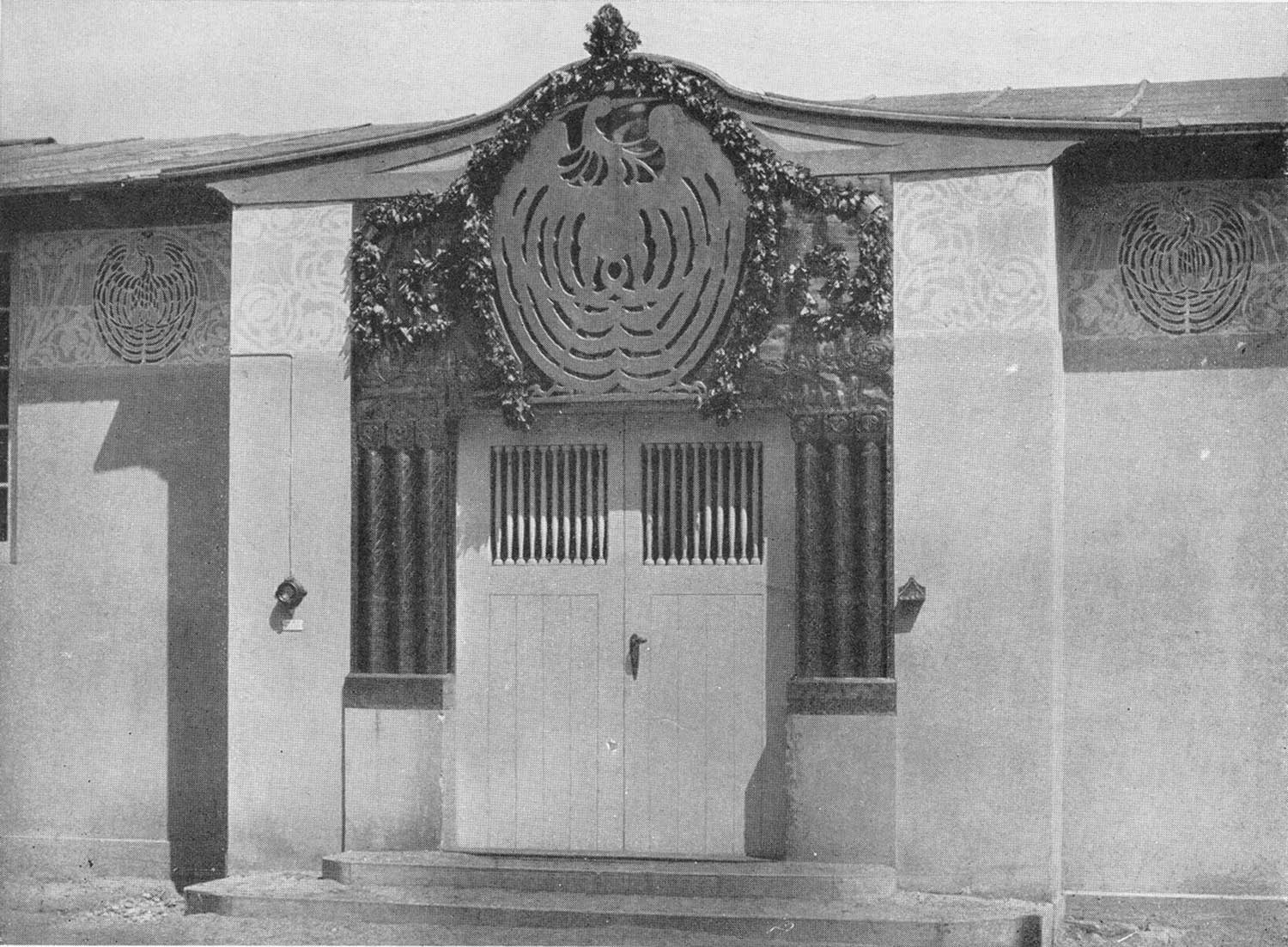Germany around 1900
Germany had become a major economic power around 1900 through industrialisation. The cities had grown so rapidly resulting in a serious housing shortage. Education and healthcare were also in a catastrophic state. Many feared the ‘ills of civilisation’ caused by industrialisation and urbanisation and called for a ‘natural way of life’. Collectively, these concepts to change society are called the Lebensreform (life-reform) movement today. One of its visionaries was Hermann Muthesius. He welcomed technical progress and sought the typical style of his time and nation, the ‘German style’. The Dritte Deutsche Kunstgewerbeausstellung (Third German Arts and Crafts Exhibition) in Dresden in 1906 was important for the reform movement. It went down in art history as a comprehensive exhibition that shaped the modern zeitgeist.

Entrance to the exhibition hall of the Dresdner Werkstätten (Dresden Workshops).
Design: Richard Riemerschmid, Pasing near Munich, Execution: Dresdner Werkstätten für Handwerkskunst, Dresden. Source: K.-P. Arnold, Hellerau: Vom Sofakissen zum Städtebau, Dresden, 1993, p. 81.
Society at odds
Around 1900, the German Empire’s society was a world of contradictions. In the years before, the country had quickly become a major economic power through industrialisation. Many new jobs had been created in the numerous factories and the cities had grown rapidly as a result. But working-class families in particular lived in the poorest conditions, there was a serious housing shortage and the education and healthcare systems were increasingly stretched to their limits.
The Lebensreform movement seeks answers
It was mainly young bourgeois circles that came together in the Lebensreform (life-reform) movement as a response to these shortcomings. Its supporters assumed that the development of industrialisation and urbanisation were leading to the ‘ills of civilisation’ among people, and called for a return to a ‘natural way of life’. Countless associations with diverse political affiliations emerged to address a wide range of social concerns. The broad spectrum of topics ranged from social reforms and progressive education to organic farming, naturopathy and vegetarianism, to the establishment of settlement cooperatives and garden cities. The will to change was also evident in the visual arts, literature, theatre, and the humanities. Leipzig publishers such as the Inselverlag and Seemann Verlag as well as the Munich magazines Jugend and Simplicissimus played a key role.
Architect and visionary: Hermann Muthesius
The architect and publicist Hermann Muthesius created the theoretical framework for reforms in the field of objective culture. In England, he had been involved with the Arts and Crafts movement initiated by William Morris, which, for example, found industrially manufactured products soulless and therefore called for a return to craftsmanship. Muthesius, on the other hand, welcomed technical progress and the industrial mode of production because he was looking for the typical style of his own era. At the same time, he was also concerned with finding an independent national culture and identity, a ‘German style’ that had no need to imitate models from England and France or base itself on historical models. For this reason, he rejected the Historicism mixture of styles as well as Art Nouveau, which for him was just a fad.
Initial spark for the modern style
The Dritte Deutsche Kunstgewerbeausstellung (Third German Arts and Crafts Exhibition) in Dresden in 1906 was an important milestone for the reform efforts. The exhibition concept exclusively allowed artists to attend as exhibitors, companies were only involved in the context of collaborations with them. As a result, the most important representatives of the German reform movement were able to appear at the exhibition. These included the architect and designer Richard Riemerschmid and his client Karl Schmidt, owner of the Deutsche Werkstätten Hellerau (Hellerau German Workshops), who presented the world’s first range of machine-made furniture called ‘Das Dresdner Hausgerät’ at the exhibition. The furniture made of standardised elements that can be disassembled could be combined with each other and united efficient production with the aesthetic demands of craftsmanship.
The Dritte Deutsche Kunstgewerbeausstellung (Third German Arts and Crafts Exhibition) went down in art history as a comprehensive exhibition that shaped the modern zeitgeist and was the initial spark for the founding of both the Deutscher Werkbund (German Association of Craftsmen), which continued the reform movement’s interests, and Hellerau Garden City.
